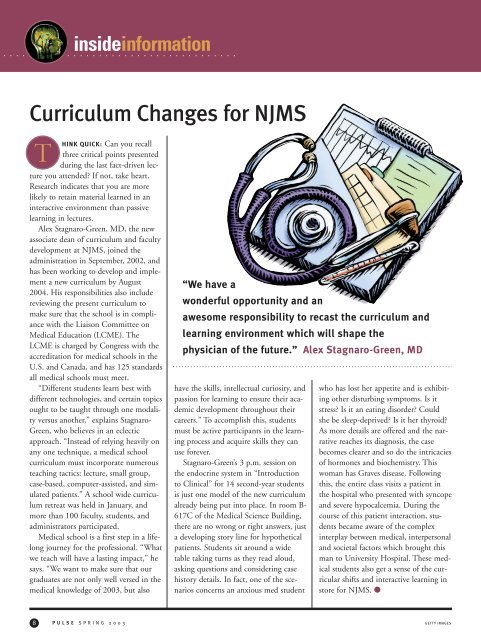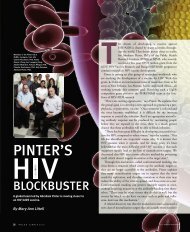changing the course of stroke - New Jersey Medical School ...
changing the course of stroke - New Jersey Medical School ...
changing the course of stroke - New Jersey Medical School ...
You also want an ePaper? Increase the reach of your titles
YUMPU automatically turns print PDFs into web optimized ePapers that Google loves.
8<br />
insideinformation<br />
Curriculum Changes for NJMS<br />
T<br />
HINK QUICK: Can you recall<br />
three critical points presented<br />
during <strong>the</strong> last fact-driven lecture<br />
you attended? If not, take heart.<br />
Research indicates that you are more<br />
likely to retain material learned in an<br />
interactive environment than passive<br />
learning in lectures.<br />
Alex Stagnaro-Green, MD, <strong>the</strong> new<br />
associate dean <strong>of</strong> curriculum and faculty<br />
development at NJMS, joined <strong>the</strong><br />
administration in September, 2002, and<br />
has been working to develop and implement<br />
a new curriculum by August<br />
2004. His responsibilities also include<br />
reviewing <strong>the</strong> present curriculum to<br />
make sure that <strong>the</strong> school is in compliance<br />
with <strong>the</strong> Liaison Committee on<br />
<strong>Medical</strong> Education (LCME). The<br />
LCME is charged by Congress with <strong>the</strong><br />
accreditation for medical schools in <strong>the</strong><br />
U.S. and Canada, and has 125 standards<br />
all medical schools must meet.<br />
“Different students learn best with<br />
different technologies, and certain topics<br />
ought to be taught through one modality<br />
versus ano<strong>the</strong>r,” explains Stagnaro-<br />
Green, who believes in an eclectic<br />
approach. “Instead <strong>of</strong> relying heavily on<br />
any one technique, a medical school<br />
curriculum must incorporate numerous<br />
teaching tactics: lecture, small group,<br />
case-based, computer-assisted, and simulated<br />
patients.” A school wide curriculum<br />
retreat was held in January, and<br />
more than 100 faculty, students, and<br />
administrators participated.<br />
<strong>Medical</strong> school is a first step in a lifelong<br />
journey for <strong>the</strong> pr<strong>of</strong>essional. “What<br />
we teach will have a lasting impact,” he<br />
says. “We want to make sure that our<br />
graduates are not only well versed in <strong>the</strong><br />
medical knowledge <strong>of</strong> 2003, but also<br />
PULSE SPRING 2003<br />
“We have a<br />
wonderful opportunity and an<br />
awesome responsibility to recast <strong>the</strong> curriculum and<br />
learning environment which will shape <strong>the</strong><br />
physician <strong>of</strong> <strong>the</strong> future.” Alex Stagnaro-Green, MD<br />
have <strong>the</strong> skills, intellectual curiosity, and<br />
passion for learning to ensure <strong>the</strong>ir academic<br />
development throughout <strong>the</strong>ir<br />
careers.” To accomplish this, students<br />
must be active participants in <strong>the</strong> learning<br />
process and acquire skills <strong>the</strong>y can<br />
use forever.<br />
Stagnaro-Green’s 3 p.m. session on<br />
<strong>the</strong> endocrine system in “Introduction<br />
to Clinical” for 14 second-year students<br />
is just one model <strong>of</strong> <strong>the</strong> new curriculum<br />
already being put into place. In room B-<br />
617C <strong>of</strong> <strong>the</strong> <strong>Medical</strong> Science Building,<br />
<strong>the</strong>re are no wrong or right answers, just<br />
a developing story line for hypo<strong>the</strong>tical<br />
patients. Students sit around a wide<br />
table taking turns as <strong>the</strong>y read aloud,<br />
asking questions and considering case<br />
history details. In fact, one <strong>of</strong> <strong>the</strong> scenarios<br />
concerns an anxious med student<br />
who has lost her appetite and is exhibiting<br />
o<strong>the</strong>r disturbing symptoms. Is it<br />
stress? Is it an eating disorder? Could<br />
she be sleep-deprived? Is it her thyroid?<br />
As more details are <strong>of</strong>fered and <strong>the</strong> narrative<br />
reaches its diagnosis, <strong>the</strong> case<br />
becomes clearer and so do <strong>the</strong> intricacies<br />
<strong>of</strong> hormones and biochemistry. This<br />
woman has Graves disease. Following<br />
this, <strong>the</strong> entire class visits a patient in<br />
<strong>the</strong> hospital who presented with syncope<br />
and severe hypocalcemia. During <strong>the</strong><br />
<strong>course</strong> <strong>of</strong> this patient interaction, students<br />
became aware <strong>of</strong> <strong>the</strong> complex<br />
interplay between medical, interpersonal<br />
and societal factors which brought this<br />
man to University Hospital. These medical<br />
students also get a sense <strong>of</strong> <strong>the</strong> curricular<br />
shifts and interactive learning in<br />
store for NJMS. ●<br />
GETTY IMAGES






